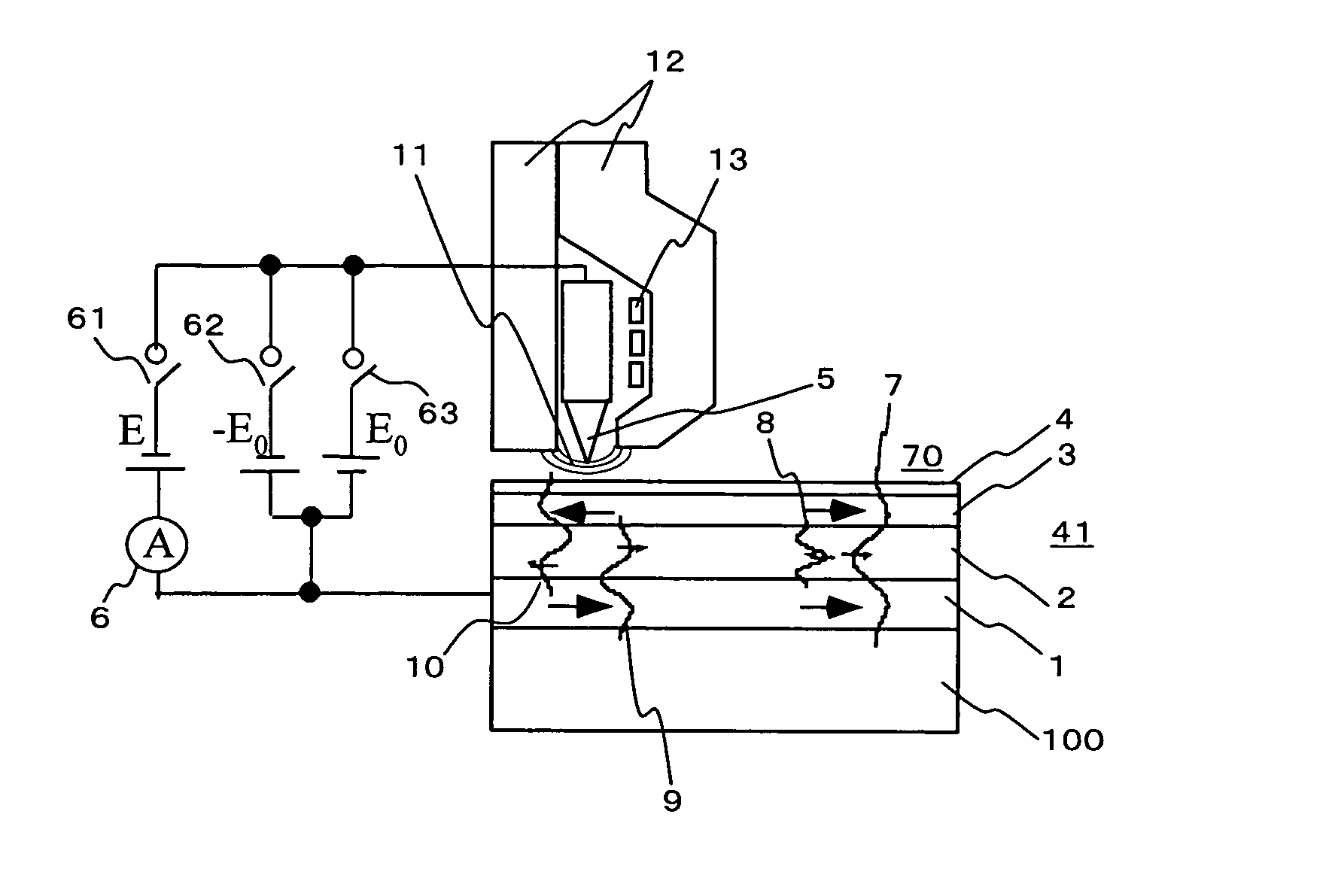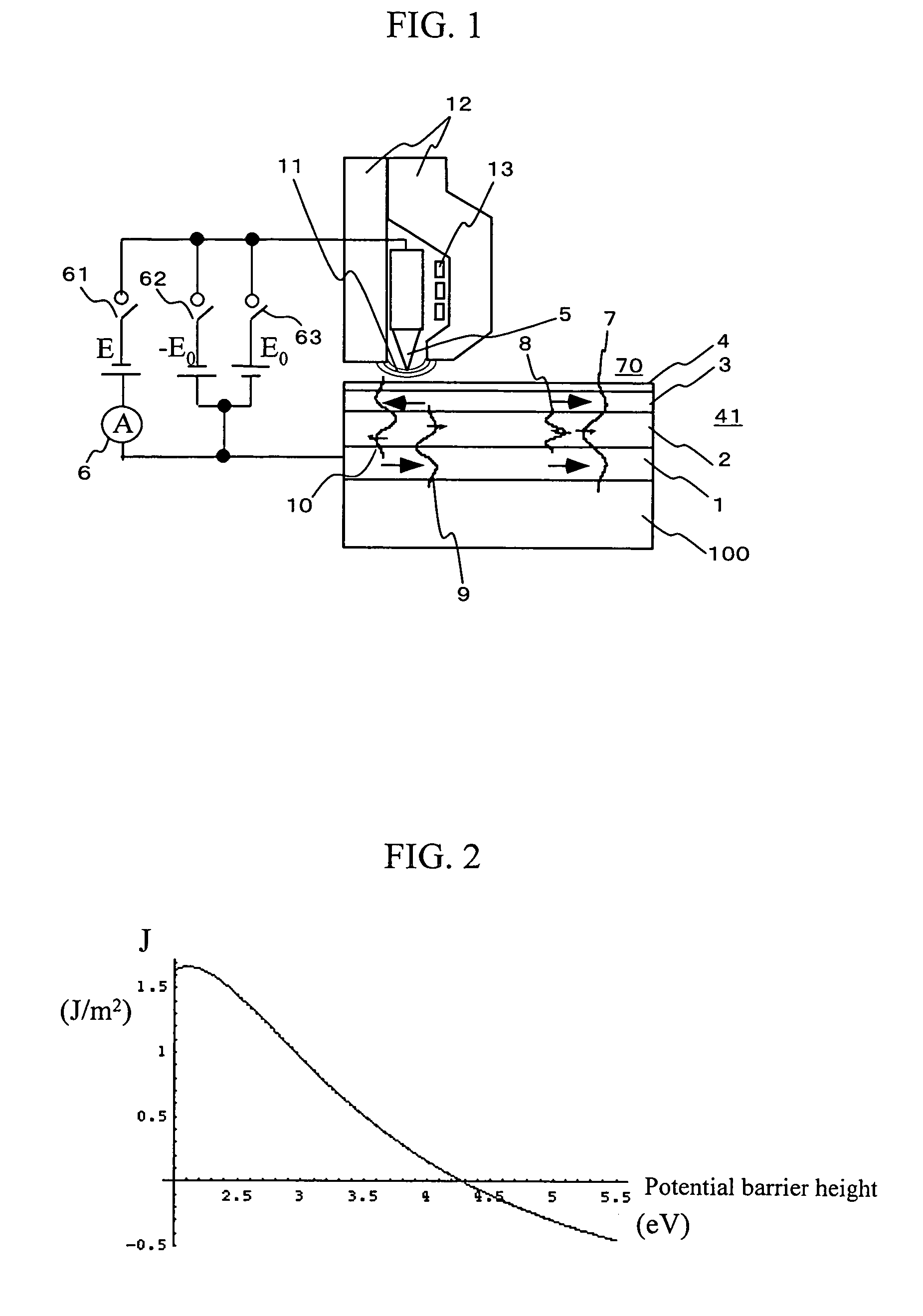Method for recording magnetic information and magnetic recording system
a magnetic information and recording system technology, applied in special recording techniques, nanoinformatics, instruments, etc., can solve the problems of difficult voltage application to a non-wiring super high recording density medium such as an hdd, and extremely difficult to fabricate these, and achieve low power consumption and high density.
- Summary
- Abstract
- Description
- Claims
- Application Information
AI Technical Summary
Benefits of technology
Problems solved by technology
Method used
Image
Examples
embodiment 1
[0043]FIG. 1 is a conceptual illustration showing one example of a main part of a magnetic recording system of the present invention. The figure shows a magnetic recording medium 70, and a metallic probe 5 and a magnetic pole 12 which are provided opposite it. The magnetic recording medium 70 consists of a multilayer film 41 providing a ferromagnetic metallic layer 1, non-magnetic metallic layer 2, the ferromagnetic metallic layer 3, and a protection film 4 which are formed by laminating in order on a substrate 100. The metallic probe 5 is placed at an extremely short distance, which is on the order of 1 nm, opposite the protection film 4 of the multilayer film 41. The metallic probe 5 is held by the same mechanism as the slider mechanism in a hard disk system. In order to control the distance between the protection film 4 and the metallic probe 5, a tunneling current may be used separately as a feedback signal. Furthermore, the feedback signal may be created by using an optical lev...
embodiment 2
[0061]FIG. 10 is a conceptual illustration showing a main part of another embodiment of a magnetic recording system of the present invention. The magnetic recording medium 70 of this embodiment has a multilayer film 41 in which an antiferromagnetic layer 18, a ferromagnetic metallic layer 1, a non-magnetic metallic layer 2, a ferromagnetic metallic layer 3, and a protection film 4 are laminated on a substrate 100. Here, a non-magnetic material, for instance Au, is used for the protection film 4, but there need not be one. The magnetization direction of the ferromagnetic layer 1 is unidirectionally fixed by the antiferromagnetic layer 18. A voltage E0 or −E0 can be applied between the metallic probe 5 and the multilayer film 41. Moreover, the magnetic pole 12 is provided close to the metallic probe 5, which is a structure such that a magnetic field can be generated at the edge region of the metallic probe 5 from the magnetic pole by energizing the coil 13.
[0062]The same as the embodi...
embodiment 3
[0065]FIG. 11 is a conceptual illustration showing a main part of another embodiment of a magnetic recording system of the present invention. The magnetic recording medium 70 of this embodiment has a multilayer film 41 in which a soft magnetic layer 19, an antiferromagnetic layer 18, a ferromagnetic metallic layer 1, a non-magnetic metallic layer 2, a ferromagnetic metallic layer 3, and a protection film 4 are laminated on a substrate 100. Here, a non-magnetic material, for instance Au, is used for the protection film 4, but there need not be one. Moreover, the magnetization direction of the ferromagnetic layer 1 is unidirectionally fixed by the antiferromagnetic layer 18, but there need not be one. A voltage E0 or −E0 can be applied between the metallic probe 5 and the multilayer film 41. Furthermore, the magnetic pole 20 is provided close to the metallic probe 5, which is a structure where a magnetic field can be generated along the path from the magnetic pole on the metallic prob...
PUM
| Property | Measurement | Unit |
|---|---|---|
| thickness | aaaaa | aaaaa |
| distance | aaaaa | aaaaa |
| magnetic exchange interaction energy | aaaaa | aaaaa |
Abstract
Description
Claims
Application Information
 Login to View More
Login to View More - R&D
- Intellectual Property
- Life Sciences
- Materials
- Tech Scout
- Unparalleled Data Quality
- Higher Quality Content
- 60% Fewer Hallucinations
Browse by: Latest US Patents, China's latest patents, Technical Efficacy Thesaurus, Application Domain, Technology Topic, Popular Technical Reports.
© 2025 PatSnap. All rights reserved.Legal|Privacy policy|Modern Slavery Act Transparency Statement|Sitemap|About US| Contact US: help@patsnap.com



